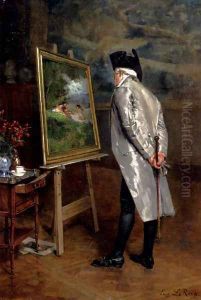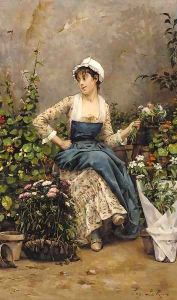Louis-Eugene Leroux Paintings
Louis-Eugène Leroux was a French painter born on April 18, 1833, in Vitre, Brittany. He was primarily known for his historical scenes and portraits. Trained in the neoclassical tradition, Leroux’s works often reflect the academic style that was prevalent in the mid-19th century, characterized by its focus on idealized beauty, precise technique, and often classical subject matter.
Leroux studied at the École des Beaux-Arts in Paris, where he was a pupil of renowned artists such as Léon Cogniet and Alexandre Cabanel. These teachers had a significant influence on Leroux's development as an artist, and he adopted their rigorous approach to draftsmanship and composition. Leroux's skill and dedication to his craft earned him a Prix de Rome in 1861, which was a prestigious scholarship that allowed young artists to study at the French Academy in Rome, Villa Medici. Spending time in Italy had a profound effect on Leroux’s work, as he was exposed to the masterpieces of the Renaissance and the rich artistic heritage of Rome.
Upon his return to France, Leroux embarked on a successful career as a painter of historical subjects and portraits. He became known for his meticulous attention to detail and his ability to convey the grandeur and drama of historical events. Though he was not as widely recognized as some of his contemporaries, Leroux's work was nevertheless appreciated for its technical proficiency and academic rigor. He exhibited regularly at the Paris Salon, the official art exhibition of the Académie des Beaux-Arts in Paris, where he received several medals for his paintings.
Apart from historical scenes, Leroux also painted religious subjects and took on portrait commissions. His portraits often depicted members of the French bourgeoisie and aristocracy, showcasing his ability to capture the likeness and character of his sitters. Despite his adherence to academic standards, Leroux's work also shows a degree of sensitivity and a subtle handling of light and shade, which adds a certain depth to his paintings.
Louis-Eugène Leroux's career spanned a period of significant change in the art world, with the rise of movements like Impressionism challenging the traditional academic style. Although he remained committed to the academic approach throughout his life, Leroux's works stand as a testament to the skills and techniques that characterized French academic painting in the 19th century. He passed away on October 11, 1905, leaving behind a body of work that continues to be studied and appreciated by art historians and enthusiasts of French academic art.

